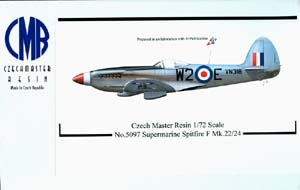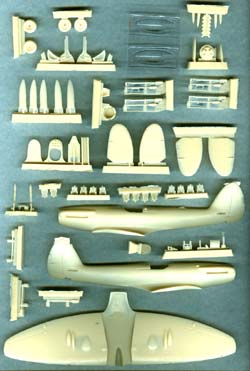CMR 1/72 Spitfire F Mk. 22/24
|
 |
Background
I reviewed CMR’s Kit No.154 of the first Griffon
powered Spitfire, the Mk. XII, in the August 2005 issue of this magazine.
The Mk. XII was essentially a Mk. Vc modified to accept the Griffon engine
and first flew in November of 1941. Development of both the airframe and
engine continued through various marks to the introduction of our subject
type, the F Mk.22 in March of 1945. 236 Mk. 22s were built before being
succeeded by the F Mk. 24, of which the first 24 were converted at the
factory from undelivered Mk.22s. A further 57 planes were built new as
Mk. 24s. The immediately discernible difference between a 22 converted
to a 24 and a new-build 24 is the serial number prefix. All 22s were prefixed
PK including the 24 converted on the assembly line to 24s. All 24s built
as such were prefixed VN. Neither the 22 nor the 24 saw combat in RAF
service. The only noticeable physical difference between the 22 and the
24 is the shorter barrels of the Hispano Mk. V, 20mm cannons installed
on the 24. The F Mk.22s were retired by, the RAF, in May 1955. The South
Rhodesian, Egyptian and Syrian Air Forces were the only others to operate
22s. Four F Mk.22 Spitfires are known to survive. I don’t know their
serials or locations. Can any reader enlighten me?
The F Mk. 24 was introduced into RAF service in November of 1946. The
last Spitfire, F Mk. 24, VN496, was delivered to the RAF February 20,
1948. 24s were in service with the RAF’s 80 Sqd. – the last
to operate the type – at Kai Tak in Hong Kong until January 1952
when they were transferred to the Royal Hong Kong Auxiliary Air Force.
The RHKAAF’s last operational flight of the 24 occurred April 21,
1955 when three of them participated in the Queen’s Birthday Flypast.
VN485, the last to land from that flight, thus has the distinction of
being the last Spitfire to fly operationally. It survives. The RHKAAF
preserved it as a mascot until July 1989 when it was transferred to the
Imperial War Museum Collection at Duxford, Cambridgeshire. It is displayed,
unrestored as it was received from the RHKAAF. PK724, fully restored,
is in the RAF Museum at Hendon in London where it is displayed along with
an early Mk. I Spitfire – the first and the last. VN486 also survives
but I don’t know its whereabouts or ownership. Can any reader enlighten
me?
As a frequent traveler for Boeing in my pre-retirement days I had the
privilege many times to see VN485 parked on the ramp in front of the RHKAAF’s
hangar at Kai Tak in the 1970s and 1980s. Unfortunately this was always
from the window of a taxiing 707 or 747 so my photos don’t show
much.
Long live the Spitfire!
The Kit
 This
is another in CMR’s next generation boxed, as opposed to bagged,
kits. The stout box contains: This
is another in CMR’s next generation boxed, as opposed to bagged,
kits. The stout box contains:
· 74 parts cast in the usual cream-colored resin,
· 2 vac canopies,
· 3 decal sheets, one of which is a correction,
· 7 pages of instructions, five of which set out seven different
suites of colors and markings for five different airplanes and
· 1 page of placement instructions for the stenciling decals.
All the decals are perfectly printed by Tally Ho! and are a visual delight
to behold.
Except for the wing being a one-piece casting the engineering of this
kit is conventional. The parts are beautifully cast with clear precise
surface detail and scribing although the trailing edges of the wings,
especially near the roots, are a trifle thick and a bit rough. This is,
however, easily dealt with. A little filing and a little sanding and all
will be right. The wheel wells exemplify the good detailing CMR is giving
us these days. They are full depth and actually extend up into the paper-thin
blister on the wing’s upper surface. Kudos to CMR for this kind
of attention to detail. The characteristic “gulling” of the
wing root is also nicely, and accurately, handled.
Conclusion
 It
appears CMR intend to kit every variant of the Spitfire. This F Mk. 22/24
kit is a terrific addition to that line. I’ve always wanted to display
an early Mk. I along with an F Mk.24 and now I can. Thank you CMR. It
appears CMR intend to kit every variant of the Spitfire. This F Mk. 22/24
kit is a terrific addition to that line. I’ve always wanted to display
an early Mk. I along with an F Mk.24 and now I can. Thank you CMR.
Our sincere thanks go to Czech Master Resin for providing the review
kit.
References
Skipping all the references for all the preceding marks of Spitfires,
the four most relevant to the F Mk.22/24 that I know of are:
· Spitfire – The History: Eric B. Morgan & Edward Shacklady,
Key Books, UK, 1987, ISBN 0-946219-48-6.
· The Supermarine Spitfire, Part 2 – Griffon Powered: Robert
Humphreys, SAM Publications, UK, 2001, ISBN 0-9533465-4-4.
· Aero Detail 30, Vickers Supermarine Griffon Spitfire: Shigeru
Nohara & Nobuhiko Okazaki, Dainippon Kaiga Co., Japan, 2001, ISBN
4-499-22741-0.
· Supermarine Spitfire Mk. XII – 24; Supermarine Seafire
Mk.I – 47, Aircam Aviation Series No. 8: Ted Hooten & Richard
Ward, Osprey Publications, UK, 1969, SBN 85045-008-X.
|
|
